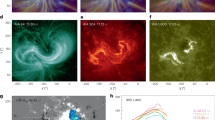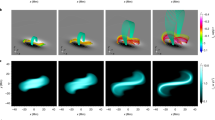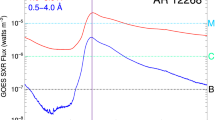Abstract
Coronal mass ejections are solar eruptions driven by a sudden release of magnetic energy stored in the Sun’s corona1. In many cases, this magnetic energy is stored in long-lived, arched structures called magnetic flux ropes2,3,4,5. When a flux rope destabilizes, it can either erupt and produce a coronal mass ejection or fail and collapse back towards the Sun6,7,8. The prevailing belief is that the outcome of a given event is determined by a magnetohydrodynamic force imbalance called the torus instability9,10,11,12,13,14. This belief is challenged, however, by observations indicating that torus-unstable flux ropes sometimes fail to erupt15. This contradiction has not yet been resolved because of a lack of coronal magnetic field measurements and the limitations of idealized numerical modelling. Here we report the results of a laboratory experiment16 that reveal a previously unknown eruption criterion below which torus-unstable flux ropes fail to erupt. We find that such ‘failed torus’ events occur when the guide magnetic field (that is, the ambient field that runs toroidally along the flux rope) is strong enough to prevent the flux rope from kinking. Under these conditions, the guide field interacts with electric currents in the flux rope to produce a dynamic toroidal field tension force that halts the eruption. This magnetic tension force is missing from existing eruption models, which is why such models cannot explain or predict failed torus events.
This is a preview of subscription content, access via your institution
Access options
Subscribe to this journal
Receive 51 print issues and online access
$199.00 per year
only $3.90 per issue
Buy this article
- Purchase on Springer Link
- Instant access to full article PDF
Prices may be subject to local taxes which are calculated during checkout



Similar content being viewed by others
References
Kunow, H., Crooker, N. U., Linker, J. A., Schwenn, R. & von Steiger, R. (eds) Coronal Mass Ejections Ch. 2, 12 (Springer, 2006)
Kuperus, M. & Raadu, M. A. The support of prominences formed in neutral sheets. Astron. Astrophys. 31, 189–193 (1974)
Chen, J. Effects of toroidal forces in current loops embedded in a background plasma. Astrophys. J. 338, 453–470 (1989)
Titov, V. S. & Démoulin, P. Basic topology of twisted magnetic configurations in solar flares. Astron. Astrophys. 351, 707–720 (1999)
Amari, T., Canou, A. & Aly, J.-J. Characterizing and predicting the magnetic environment leading to solar eruptions. Nature 514, 465–469 (2014)
Ji, H., Wang, H., Schmahl, E. J., Moon, Y.-J. & Jiang, Y. Observations of the failed eruption of a filament. Astrophys. J. 595, L135–L138 (2003)
Török, T. & Kliem, B. Confined and ejective eruptions of kink-unstable flux ropes. Astrophys. J. 630, L97–L100 (2005)
Joshi, N. C. et al. Confined partial filament eruption and its reformation within a stable magnetic flux rope. Astrophys. J. 787, 11 (2014)
Forbes, T. G. & Isenberg, P. A. A catastrophe mechanism for coronal mass ejections. Astrophys. J. 373, 294–307 (1991)
Kliem, B. & Török, T. Torus instability. Phys. Rev. Lett. 96, 255002 (2006)
Fan, Y. & Gibson, S. E. Onset of coronal mass ejections due to loss of confinement of coronal flux ropes. Astrophys. J. 668, 1232–1245 (2007)
Liu, Y. Magnetic field overlying solar eruption regions and kink and torus instabilities. Astrophys. J. 679, L151–L154 (2008)
Démoulin, P. & Aulanier, G. Criteria for flux rope eruption: non-equilibrium versus torus instability. Astrophys. J. 718, 1388–1399 (2010)
Savcheva, A., Pariat, E., van Ballegooijen, A., Aulanier, G. & DeLuca, E. Sigmoidal active region on the sun: comparison of a magnetohydrodynamical simulation and a nonlinear force-free field model. Astrophys. J. 750, 15 (2012)
Sun, X. et al. Why is the great solar active region 12192 flare-rich but CME-poor? Astrophys. J. 804, L28 (2015)
Myers, C. E. Laboratory Study of the Equilibrium and Eruption of Line-Tied Magnetic Flux Ropes in the Solar Corona. http://arks.princeton.edu/ark:/88435/dsp01dv13zw44b, PhD thesis, Princeton Univ. (2015)
Hansen, J. F. & Bellan, P. M. Experimental demonstration of how strapping fields can inhibit solar prominence eruptions. Astrophys. J. 563, L183–L186 (2001)
Soltwisch, H. et al. Flarelab: early results. Plasma Phys. Contr. Fusion 52, 124030 (2010)
Tripathi, S. K. P. & Gekelman, W. Laboratory simulation of arched magnetic flux rope eruptions in the solar atmosphere. Phys. Rev. Lett. 105, 075005 (2010)
Gold, T. & Hoyle, F. On the origin of solar flares. Mon. Not. R. Astron. Soc. 120, 89–105 (1960)
Sakurai, T. Magnetohydrodynamic interpretation of the motion of prominences. Publ. Astron. Soc. Jpn. 28, 177–198 (1976)
Hood, A. W. & Priest, E. R. Critical conditions for magnetic instabilities in force-free coronal loops. Geophys. Astrophys. Fluid Dyn. 17, 297–318 (1981)
Mikic´, Z., Schnack, D. D. & van Hoven, G. Dynamical evolution of twisted magnetic flux tubes. I—Equilibrium and linear stability. Astrophys. J. 361, 690–700 (1990)
Török, T., Kliem, B. & Titov, V. S. Ideal kink instability of a magnetic loop equilibrium. Astron. Astrophys. 413, L27–L30 (2004)
Kruskal, M. & Schwarzschild, M. Some instabilities of a completely ionized plasma. Proc. R. Soc. Lond. A 223, 348–360 (1954)
Shafranov, V. The stability of a cylindrical gaseous conductor in a magnetic field. Sov. J . At. Energy 1, 709–713 (1956)
Ryutov, D. D., Furno, I., Intrator, T. P., Abbate, S. & Madziwa-Nussinov, T. Phenomenological theory of the kink instability in a slender plasma column. Phys. Plasmas 13, 032105 (2006)
Olmedo, O. & Zhang, J. Partial torus instability. Astrophys. J. 718, 433–440 (2010)
Ji, H., Prager, S. C. & Sarff, J. S. Conservation of magnetic helicity during plasma relaxation. Phys. Rev. Lett. 74, 2945–2948 (1995)
Taylor, J. B. Relaxation and magnetic reconnection in plasmas. Rev. Mod. Phys. 58, 741–763 (1986)
Moore, R. L., Sterling, A. C., Hudson, H. S. & Lemen, J. R. Onset of the magnetic explosion in solar flares and coronal mass ejections. Astrophys. J. 552, 833–848 (2001)
Antiochos, S. K., DeVore, C. R. & Klimchuk, J. A. A model for solar coronal mass ejections. Astrophys. J. 510, 485–493 (1999)
Shafranov, V. Plasma equilibrium in a magnetic field. Rev. Plasma Phys. (ed. Leontovich, M. A. ) 2, 103–152 (1966)
Bateman, G. MHD Instabilities (MIT Press, 1978)
Kliem, B., Lin, J., Forbes, T. G., Priest, E. R. & Török, T. Catastrophe versus instability for the eruption of a toroidal solar magnetic flux rope. Astrophys. J. 789, 46 (2014)
Hsu, S. C. & Bellan, P. M. Experimental identification of the kink instability as a poloidal flux amplification mechanism for coaxial gun spheromak formation. Phys. Rev. Lett. 90, 215002 (2003)
Furno, I. et al. Current-driven rotating-kink mode in a plasma column with a non-line-tied free end. Phys. Rev. Lett. 97, 015002 (2006)
Bergerson, W. F. et al. Onset and saturation of the kink instability in a current-carrying line-tied plasma. Phys. Rev. Lett. 96, 015004 (2006)
Oz, E. et al. Experimental verification of the Kruskal-Shafranov stability limit in line-tied partial-toroidal plasmas. Phys. Plasmas 18, 102107 (2011)
Yamada, M. et al. Study of driven magnetic reconnection in a laboratory plasma. Phys. Plasmas 4, 1936–1944 (1997)
Bellan, P. M. & Hansen, J. F. Laboratory simulations of solar prominence eruptions. Phys. Plasmas 5, 1991–2000 (1998)
Lemen, J. R. et al. The Atmospheric Imaging Assembly (AIA) on the Solar Dynamics Observatory (SDO). Sol. Phys. 275, 17–40 (2012)
Yoo, J., Yamada, M., Ji, H. & Myers, C. E. Observation of ion acceleration and heating during collisionless magnetic reconnection in a laboratory plasma. Phys. Rev. Lett. 110, 215007 (2013)
Acknowledgements
We thank R. Cutler for constructing the flux rope experiment and for myriad technical contributions. We also thank F. Scotti and P. Sloboda for additional technical contributions and R. M. Kulsrud for theoretical discussions. This research is supported by Department of Energy (DoE) contract number DE-AC02-09CH11466 and by the National Science Foundation/DoE Center for Magnetic Self-Organization (CMSO).
Author information
Authors and Affiliations
Contributions
C.E.M., M.Y. and H.J. designed the laboratory experiments. C.E.M., J.Y. and J.J.-A. carried out the experiments and processed the data. C.E.M., M.Y., H.J., J.Y., W.F. and J.J.-A. interpreted the laboratory results. A.S. and E.E.DeL. placed the laboratory results in the context of solar observations and modelling. C.E.M. analysed the laboratory data, prepared the figures, and wrote the manuscript. All authors contributed to the revision of the manuscript.
Corresponding author
Ethics declarations
Competing interests
The authors declare no competing financial interests.
Additional information
The digital data for this paper can be found at http://arks.princeton.edu/ark:/88435/dsp01j3860933c.
Extended data figures and tables
Extended Data Figure 1 Experimental setup.
A plasma arc (pink) is maintained between two electrodes that are mounted on a glass substrate. The electrodes, which serve as the flux rope footpoints, are horizontally separated by 2xf = 36 cm, and they have a minor radius of af = 7.5 cm. The vertical distance from these footpoints to the vessel wall is zw ≈ 70 cm. Four magnetic field coil sets (two inside the vessel, two outside) work in concert to produce a variety of potential magnetic field configurations. More specifically, the two orange coil sets are used to produce the guide potential field, while the two blue coil sets are used to produce the strapping potential field.
Extended Data Figure 2 Components of the potential magnetic field configuration.
The strapping field runs perpendicular to the flux rope axis and produces the well known strapping force, whose rapid spatial decay can trigger the torus instability. The guide field, on the other hand, runs toroidally along the flux rope axis. It stabilizes the kink instability and generates a confining magnetic tension force. The total potential magnetic field, which is the superposition of the guide and strapping field contributions, is obliquely aligned to the flux rope.
Extended Data Figure 3 Magnetic field analysis of a characteristic eruptive event.
a, The spatial evolution of the eruptive perturbation (red), with the failed torus event from Fig. 3a for comparison (black). b, Evolution of the poloidal and toroidal magnetic fluxes. Note the monotonic evolution of both fluxes. c, Hoop (Fh), strapping (Fs), and tension (Ft) force evolution, which are also strictly monotonic. d, e, Sequenced JT and BTi evolution. Note that the current profile remains uniform and rises steadily towards the wall of the machine. A new flux rope is forming at low altitude in the final frame.
Extended Data Figure 4 Sample in situ magnetic field measurements.
Seven linear magnetic field probes (yellow) are inserted vertically into the flux rope plasma. The alignment of the two-dimensional probe plane is either (a) parallel to the footpoint axis or (b) perpendicular to it. In the sample data, the colour represents the out-of-plane field, while the vectors represent the in-plane field. The position of the magnetic axis in the toroidal cross-section (the solid black line) is determined by the reversal in the out-of-plane poloidal magnetic field, By. The position of the magnetic axis in the poloidal cross-section is defined as the O-point in the circulating in-plane field (By, Bz). The out-of-plane field in the latter case is the ‘internal’ toroidal field of the flux rope BTi, which is paramagnetic in nature.
Extended Data Figure 5 Height–time plots from four representative flux rope discharges.
a, Mean toroidal plasma current waveform showing that the plasma current is nearly the same in all four cases (the light green band is the standard deviation). b, Four sample height–time plots, one from each of the four stability regimes identified in Fig. 2. The magnetic axis position (the black line) is defined by the zero-crossing in the By(t, z) data, which is shown in colour. The red line in each frame is the time-averaged height of the flux rope apex  . This waveform provides the height at which qa and n are measured in each discharge. c, Table of extracted flux rope parameters for each discharge.
. This waveform provides the height at which qa and n are measured in each discharge. c, Table of extracted flux rope parameters for each discharge.
Extended Data Figure 6 Magnetic field and current density data for computing flux rope forces.
The probe array is aligned as shown in Extended Data Fig. 4b. In the left panel, the colour is the toroidal current density, JT, and the vectors are the poloidal magnetic field, BP. In the right panel, the colour is the internal toroidal field BTi, and the vectors are the poloidal current density JP. With all components of J and B measured, the force densities listed in Extended Data Table 3 can be readily computed. The contours in the left panel are contours of the poloidal flux function ψ(y, z) (see equation (4)). The minor radius of the rope a(θ) is defined by the poloidal flux contour shown in red (see Methods).
Supplementary information
Representative stable and erupting flux rope discharges.
Top left: Experimental setup showing the pink arched flux rope attached to two conducting footpoints. The yellow vertical lines represent the in situ magnetic probes (see Methods). Bottom left: Height-time histories of the two flux rope discharges. Right: Frame sequences with the measured out-of-plane magnetic field overlaid on corresponding fast camera visible light images. The measured magnetic axis locations (the solid lines) are defined by the reversal of the out-of-plane magnetic field (see Methods). See Fig. 1 for a breakout of individual frames from this video. (MOV 1098 kb)
Rights and permissions
About this article
Cite this article
Myers, C., Yamada, M., Ji, H. et al. A dynamic magnetic tension force as the cause of failed solar eruptions. Nature 528, 526–529 (2015). https://doi.org/10.1038/nature16188
Received:
Accepted:
Published:
Issue Date:
DOI: https://doi.org/10.1038/nature16188
This article is cited by
-
Magnetic reconnection in the era of exascale computing and multiscale experiments
Nature Reviews Physics (2022)
-
The role of non-axisymmetry of magnetic flux rope in constraining solar eruptions
Nature Communications (2021)
-
Analysis of the Helical Kink Stability of Differently Twisted Magnetic Flux Ropes
Solar Physics (2020)
-
Explosive Magnetotail Activity
Space Science Reviews (2019)
-
Ideal MHD instabilities for coronal mass ejections: interacting current channels and particle acceleration
Reviews of Modern Plasma Physics (2019)
Comments
By submitting a comment you agree to abide by our Terms and Community Guidelines. If you find something abusive or that does not comply with our terms or guidelines please flag it as inappropriate.



